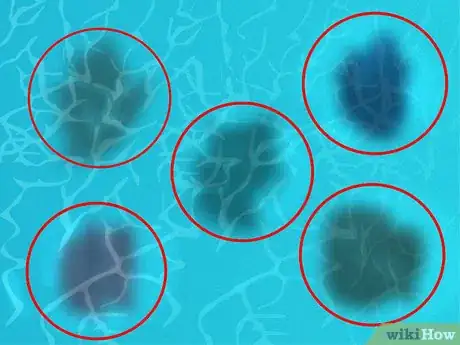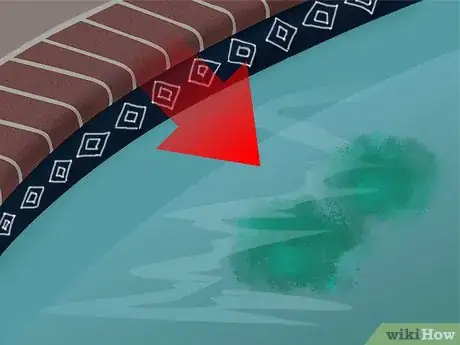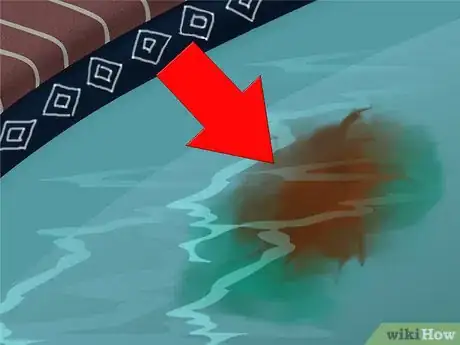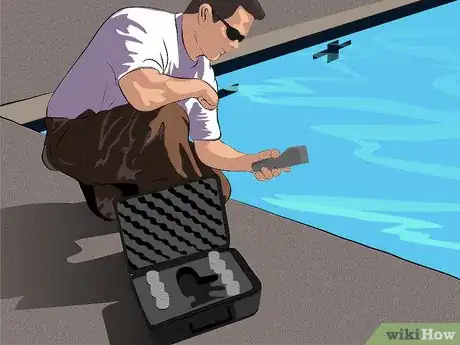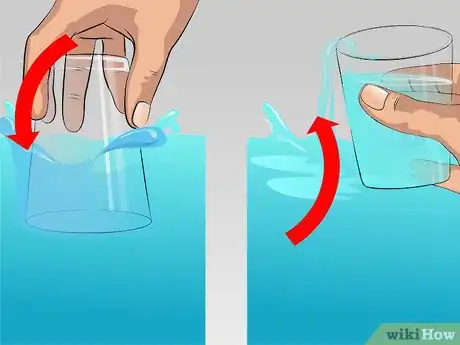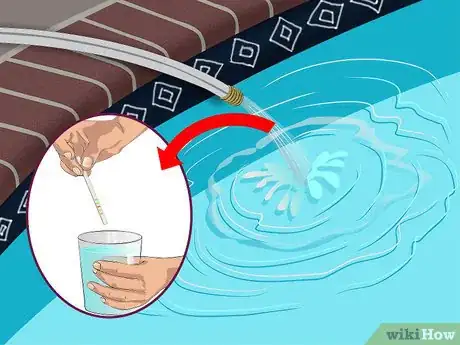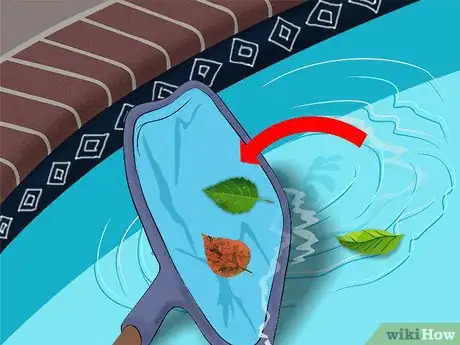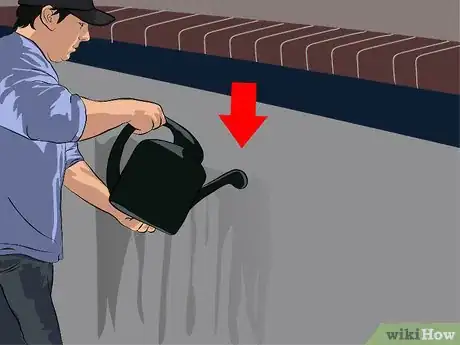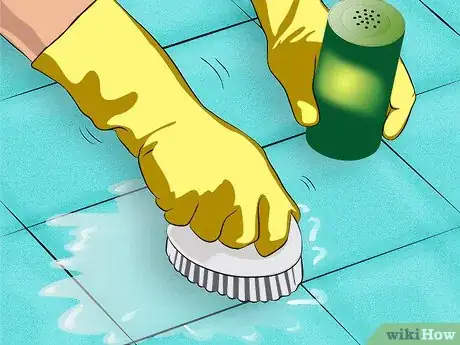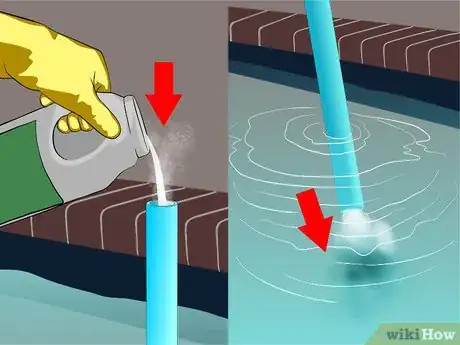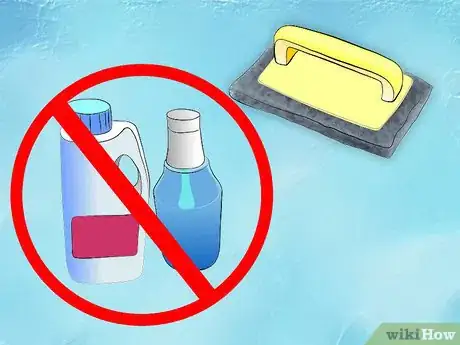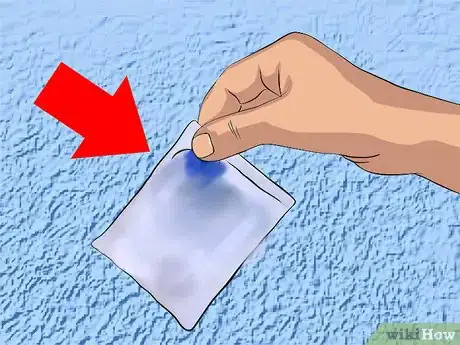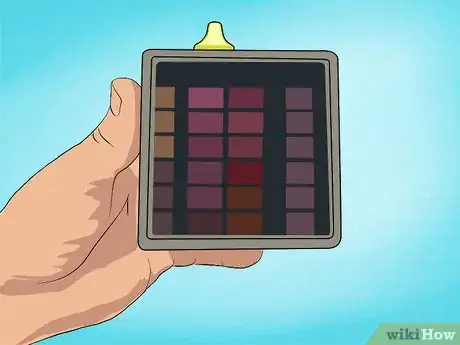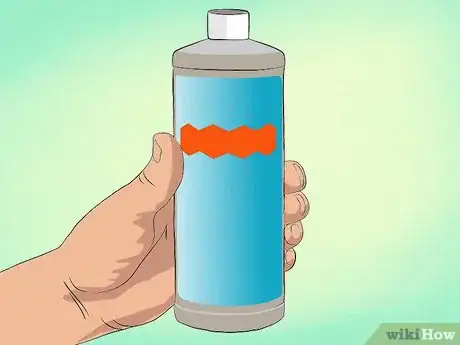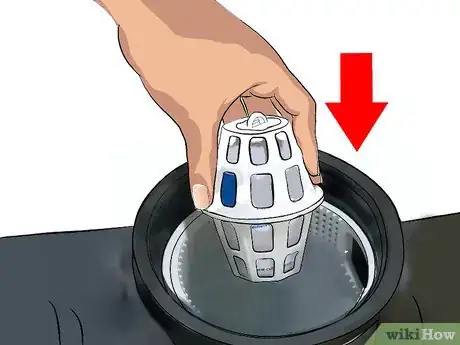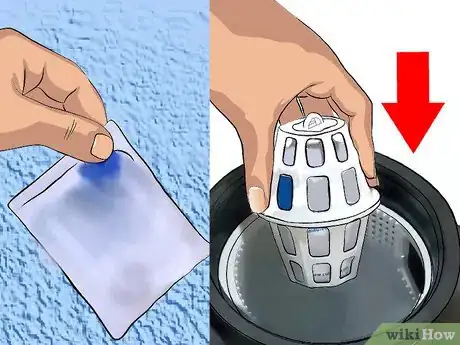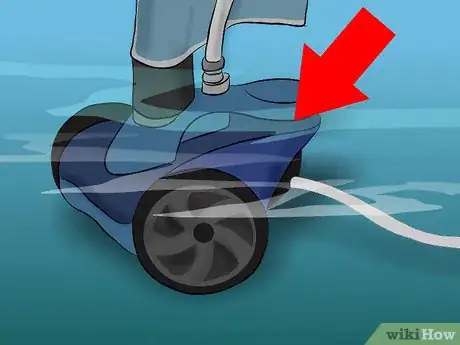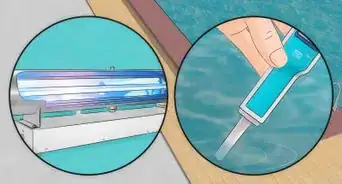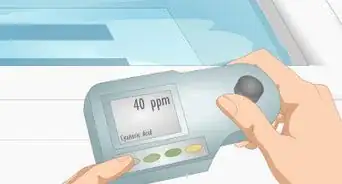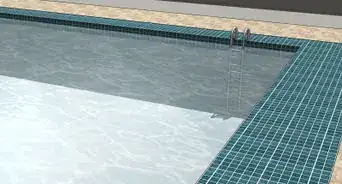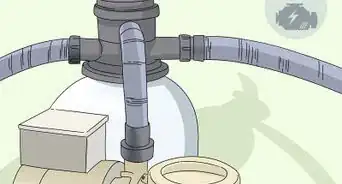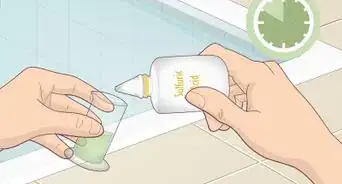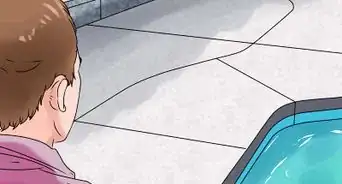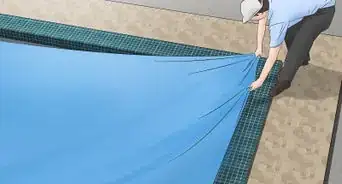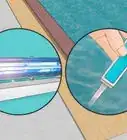This article was co-authored by Oz Tzalalihin. Oz Tzalalihin is a Project Manager for Vitoli Builders, based in Calabasas, California. He has a passion for working with sloped terrains and has shared his expertise through contributions to local publications. Oz holds a PMP (Project Management Professional) degree from Cornell University and specializes in building pools and structures on hillside properties. With his education and experience, he is a valuable asset to Vitoli Builders and is dedicated to delivering quality results and smooth construction.
wikiHow marks an article as reader-approved once it receives enough positive feedback. In this case, several readers have written to tell us that this article was helpful to them, earning it our reader-approved status.
This article has been viewed 804,674 times.
Jumping into a nice, cool pool provides a great escape from the summer heat. However, swimming in a dirty pool can put a damper on the fun and keep people out of the pool. Stains occur naturally in a pool and require regular maintenance to keep them out. Sometimes, it can be fairly easy to get rid of stains, but other times, those hard-to-remove spots can take a bit more than a simple scrub. Pool stains on the wall or floor of a swimming pool can be caused by metals in the pool water, or by an organic material left in the pool. Your first clue to diagnosing a pool stain is to check out it's color.
Steps
Diagnosing the Stain
-
1Look at the color of your pool stain to classify the cause. There are various stain colors that commonly appear in pools, and identifying yours will lead you in the right direction for treatment. Depending on the cause of the stain, you will need a unique removal plan.
- The two main stain categories are metal and organic based stains, which come in a variety of colors.
- These color combinations include green-brown, red-blue, blue-green-black, green-brown-red, pinkish-red, or brown-black-purple. Try to distinguish which color combination your stain is.[1]
-
2Watch for organic stains on the floor of your pool. These are likely caused by leaves, berries, algae, worms, dead animals, or other organic debris that will leave stains if allowed to settle on the pool surface. If they are not removed right away, they will sink down and begin to decay on your pool's floor. Fortunately, organic stains can be easy to remove.
- Organic stains are typically green, brown, or bluish-purple. It may be easy to diagnose organic stains if you can see organic debris like leaves settled at the bottom of your pool floor.
- If an organic stain is suspected, try applying a small amount of chlorine directly to it. An organic stain will dissolve easily with a soft head brush, whereas a metal stain will stay put.
Advertisement -
3Be on the lookout for inorganic or metal based stains. These substances can inadvertently be introduced into pools from well water or corrosion from copper pipes. It only takes the copper from the size of a penny to be oxidized in your pool and cause major stains. The types of metals that can sneak in your pool includes rust, manganese, iron, and copper. If there are rust colored stains on the pool wall below a ladder, the source is probably a metal, and you should examine the ladder for corrosion too. Check near the stairs, around the drain, and under the lip of the pool for discoloration. Stains that appear reddish brown or very dark are typically related to metals in your pool water.
- The metals that commonly cause pool stains are iron, manganese & copper. Copper is from ionizers and corrosion of copper and brass pipes. This will result in blue, green, teal, black or dark purple stains. Iron is from well water, corrosion of iron pipes and fittings and will result in rusty brown, gray or greenish-brown stains. Manganese is from well water and will result in pink, dark brownish-black or purple stains. Calcium comes from plaster, grout, mortar, or cal-hypo chlorine shock and shows as white crystals.[2]
- If you have a metal based stain, it is important to know exactly which metal is causing you problems in order to properly treat it.
- A common cause of blue-green copper pool stains is improper chemical maintenance. Low pH and high chlorine levels can also erode the copper heat exchanger in a pool heater. Maintaining proper water balance makes it easier to keep metal stains from developing.
-
4Seek out professional assistance. If you want to leave the stain removal to the experts, use your yellow pages to find pool specialists or pool retailers in your area. You will need to take a pool sample to their location so they can test your water and determine exactly what kinds and levels of metals are plaguing your pool. The professional can then recommend a special additive designed to remove your metal stains.
-
5Be sure to take a proper water sample for diagnosis. Use a clean cup or bottle and hold it upside down so that the opening is facing the floor of the pool. Push it completely under water and turn it right-side up to collect the water sample. Do not take the sample near any jets or skimmer openings. It is best to take the sample from the middle of your pool. If that isn't possible, get as close to the middle as you can for the most accurate test results.[3]
-
6Make sure you perform a TOTAL metal test as part of your regular testing. FREE metal testing only measures non-sequestered metals, but total metal testing measures all the metal in your water sample.
-
7Use test strips to test the water at home. Take a water sample from the middle of your pool. Once you have your water sample, quickly dip one, dry test strip into the water. Without shaking off the excess water, hold it still in the air for about 15 seconds. The strip will then change colors, and you will need to match up the colors of the strip to the back of the bottle to get your readings. There are many different types of test strips you can buy that check for various things, but you really only need to check for pH, alkalinity and free chlorine.[4]
- Use test strips at least once a week. Bring a sample to your local pool store once a month to have it professionally checked, especially when opening and closing your pool.
-
8Try a liquid test kit. There are very advanced liquid test kits, but for a home pool, you can stick with pH and chlorine or phenol red and OTO chlorine test kits. Liquid tests kit can be very accurate but you have to be able to translate the color outcomes well. For example, once you drop the chemicals into your water sample, they are going to change a color, and depending on how bright or dark it is, you have to accurately match it to the directions on the package for a proper treatment plan. Beware, it can be difficult to decipher the different colors and color shades.[5]
- OTO chlorine is the chemical that tests for total chlorine. It's a yellow liquid you add to your sample. The more yellow, the more chlorine there is in your pool water.
- Phenol red is a red chemical you add to a small sample of water to check the pH balance. The more red the water, the higher the pH balance is.
- With a liquid test kit, it's hard to see the low end of the colors. Make sure you use a white background to examine the colors to be accurate.
-
9Determine if your fill water is the problem. If you fill your pool from a well, test that water directly before filling your pool. If you determine that there are high amounts of metals in that water, drain your swimming pool to about 1/4 or 1/2 way, and refill it with softened water. You will then need to circulate the water for at least 48 hours and have it re-tested. If there is still a high concentration of metals, repeat the process.[6]
- If your fill water is acceptable, metals are most likely being introduced into your pool water through corrosion. Check all pool equipment for corrosion to make sure they are not leaking metals into your pool water.
Treating Organic Stains
-
1Remove the organic materials from your pool surface. Typically, greenish-brown colored stains are related to something organic like algae or leaves that were left on the pool floor. These substances need to be removed as part of the treatment. Organic pool stains are not usually hard to remove but with time, your pool will start to have a dull, light-brown color that you won't be able to remove. The brown discoloration happens very slowly and can be hard to notice at first.
- If you have trees that hang over your pool, watch for leaves, branches, or fruit that may drop down into the water. You can use a pool skimmer to routinely clean out the debris.
- Any organic debris that floats to the bottom of your pool needs to be removed with a pool vacuum. You can use a hand-held vacuum or an automatic pool vacuum that uses a sensor.
-
2Acid wash your pool. If permanent stains do develop, you can drain your pool water and acid wash your pool if it has a plaster liner. This is not something that you can practice all of the time, as it involves a purposeful stripping of a thin layer of pool plaster. In order to restore the bright white surface, you need to use an acid wash around every five years.
-
3Try an enzyme shock treatment and stiff scrub brush to remove stains. This may quickly remove greenish-brown colored stains that build up from organic stains. You may also want to try an enzyme based pool chemical. All natural pool enzymes will eat away at organic material to remove the pool stain with little or no scrubbing and without the use of harsh chemicals that damage pool liners. If your stain is all around the waterline of the pool because of material floating at the top, an enzyme-based cleaner will help to break down organic compounds and oils by speeding up the chemical reactions that assist in making stains virtually disappear on their own. Follow up with a thorough brushing to make sure you've got all the left behind debris and oil.
-
4Shock your pool with chlorine. Organic stains are best addressed by heavily chlorinating the water, then giving your pool a little TLC with a good brushing. You can use a long handled stiff brush to get all around your pool. Try pouring a small amount of chlorine shock right over an organic stain to make it disappear instantly. Beware, this works great on plaster pools, but don't try this to remove stains on a vinyl pool because it could remove the liner pattern.[7]
- Test the water to ensure the balances of pH and alkalinity are where they should be. The pH level should be between 7.4 and 7.6, while alkalinity should be between 100 and 150 ppm (parts per million).
-
5Remove localized stains with muriatic acid and a scrub brush. Carefully pour the acid into a piece of PVC pipe, and deliver the acid to a stain on the pool wall. Be cautious, if the whole pool is lightly stained, you may end up with a a bright white spot that is surrounded by a darker color.
- After using your stain removing product, make sure you shock the pool so that you have a sufficient amount of chlorine in the water before it goes green from an algae outbreak.
-
6Skip harsh chemicals with an abrasive scrub. Try a tile grout scrubber to get in between fine cracks. There are two different types of heads you can purchase. One is for a concrete pool, and the other is for a vinyl pool, so make sure you check which one you need before purchasing. Once you have it, you can attach it to your pool pole to remove those hard to reach pool stains.
Treating Metal Stains
-
1Take the proper steps to get rid of any metal in your pool. One option is to buy a metal removal product that sits in the skimmer basket for up to one month. This is the first step of most stain removal processes and will help your overall efforts to clean your pool. There are many sizes to choose from that offer various degrees of strength, so if possible, ask a pool professional which kind is best for your situation.
-
2Turn off all machines and pool equipment near the pool water. This includes chlorinators, metal ionizers, generators, UV systems, and ozone generators. It is best to avoid water contact with pool heaters, chlorine generators and other non-filtration systems that are near your pool during the process of stain removal and heavy chemical treatments.
-
3Lower the chlorine level in your pool between 0 and 2 parts per million. The lower the chlorine level is, the less ascorbic acid you need to clean your pool. You can wait for the chlorine level to drop naturally with rainfall or time, but if time is a factor, you can add sodium thiosulfate to the water, following the manufacturer's instructions.[8]
- Add an algaecide to the pool water. Be sure to follow the instructions on the product box regarding the method of application and how much you need for your size pool. This prevents algae from growing with lowered chlorine levels.
-
4Remove metal stains with ascorbic acid. Minerals respond best to chemicals, and if you believe your stain is related to metals, or if the suggestions above for organic pool stains do not improve your stain, try ascorbic acid based pool products. If you want to try an easy and effective home method, crush up vitamin C tablets, and rub them against the stain. After a few minutes, check to see if it begins to lighten.[9] Keep in mind that ascorbic acid is best for treating iron stains, while citric acid is best for treating copper stains.
- Treat large stains by adding ascorbic acid to the pool water by sprinkling it evenly over the surface of the water. Start by using a 1/2 pound of ascorbic acid per 10,000 gallons of water in the pool.
- Set the filter on "circulate" and turn it on. Allow the ascorbic acid to work for a half-hour.
- Check the pool to see if the stains are gone. If they're still there, add more ascorbic acid, and let the filter circulate the treatment for another half-hour. Repeat this process until the pool is clean.
-
5Restore a healthy chemical balance in the pool water. It is important to monitor the pH, alkalinity and hardness levels to their appropriate range which is determined by the size of the pool. You should turn on any automatic chlorinators, chlorine generators, UV systems, and ozone generators. Place a fresh metal eliminator pack in the pool skimmer basket, or a larger metal eliminator pack in the pump basket, to keep metal levels low, and help maintain a stain-free pool throughout the season.
Preventing All Stains
-
1Make pool maintenance a regular routine. Prevention is much easier to maintain than stain removal and cures. Have a sample of your pool water tested for ideal chemical balances either by a professional or with an at home kit every week. If you fill your pool from a source other than "city water" you should also test the fill water because well water carries a lot of iron that can leave behind stains.[10]
- Do small shock treatments every week to prevent algae outbreaks.
- Scrub the bottom of your pool several times a week as a preventative measure.
-
2Prevent metallic stains from making a return. Make sure to regularly test your water for metals, as the stains will keep coming back if you have a highly metallic pool. Remember, metals are naturally occurring and can be added to your swimming pool with fill water, or they may be introduced into the pool water through corrosion of your pool equipment or plumbing. It is important to monitor metal levels every week.[11]
- Use a sequestering agents, also known as Chelators. They tie-up minerals in a solution which prevent them from floating free in the water causing stains. Just make sure they do not have phosphonic acids, as they break down into phosphates and can cause an algae outbreak.
- Disposable absorbent bags also remove and eliminate metals. Just drop one into your skimmer basket (or pump basket) and it will absorb metals such as copper, iron, manganese, cobalt, silver, and nickel.
-
3Keep organic pool stains out of your pool by keeping your pool water free of natural debris. Either skim your pool or use an automatic pool vacuum to clear out leaves, berries and branches that fall in. You should also invest in a durable winter pool cover that you can use when you are not using your pool.
- Dark pool staining can occur from mudslides or mulch-slides into the pool. If you can't prevent these materials from going into your pool, try re-coating your pool with a dark colored plaster or liner to help hide these types of pool stains.
Community Q&A
-
QuestionWhat could be causing a brownish stain to my pool liner? The water samples are good from the pool.
 Community AnswerI used Atlantica on a Friday, the next Tuesday I did the weekly chemicals and the next morning the liner was brown around the top. It could be from something like that.
Community AnswerI used Atlantica on a Friday, the next Tuesday I did the weekly chemicals and the next morning the liner was brown around the top. It could be from something like that. -
QuestionWhat is wrong if I poured algaecide into my pool and the water surface has turned a thick white? Will it go away?
 Community AnswerNothing's wrong. The algaecide has killed the algae, and the dead algae has turned white. It will all filter out when you turn on the pump.
Community AnswerNothing's wrong. The algaecide has killed the algae, and the dead algae has turned white. It will all filter out when you turn on the pump. -
QuestionHow do I remove a yellow stain on a vinyl liner at the water line?
 Community AnswerRepaint the area. To prevent it from happening again, keep refreshing the water.
Community AnswerRepaint the area. To prevent it from happening again, keep refreshing the water.
Thing You Will Need
- Sodium thiosulfate
- Algaecide
- Vitamin C tablets
- Ascorbic acid
- Rust-preventing commercial enzyme
- Metal eliminator
Warnings
- If you have a heater on your swimming pool and find copper stains or excessive amounts of copper in your water when tested, immediately test the pool pH and Alkalinity levels and properly maintain them going forward. The plumbing inside a swimming pool heater, called the “heat exchanger", is made of copper. If the pool pH and pool Alkalinity levels are not properly maintained, this heat exchanger will quickly corrode and dissolve copper into the pool water causing pool stains and quickly destroy the heater. If your pH ever drops below 7.0, the water becomes acidic and begins to dissolve all surfaces and metals. Check your pH level several times a week to prevent problems of low pH.⧼thumbs_response⧽
Expert Interview
-BCD_sample.webp)
Thanks for reading our article! If you'd like to learn more about resurfacing a pool, check out our in-depth interview with Oz Tzalalihin.
References
- ↑ http://www.poolcenter.com/color
- ↑ http://www.poolcenter.com/color
- ↑ http://www.swimuniversity.com/how-to-test-pool-water/
- ↑ http://www.swimuniversity.com/how-to-test-pool-water/
- ↑ http://www.swimuniversity.com/how-to-test-pool-water/
- ↑ http://blog.intheswim.com/swimming-pool-stains-removal-guide/
- ↑ http://www.poolcenter.com/color
- ↑ http://homeguides.sfgate.com/rid-metal-stains-swimming-pool-34235.html
- ↑ http://homeguides.sfgate.com/rid-metal-stains-swimming-pool-34235.html
About This Article
To diagnose and remove any swimming pool stain, start by identifying the color of the stain. Green, brown, and bluish-purple stains, for example, are typically organic stains, whereas metal based stains are usually blue, teal, black, or dark purple. If the stain is organic, add chlorine to shock the pool, then scrub the stain with a long handled scrub brush. For metal stains, start by adding sodium thiosulfate to lower the chlorine level. Then, release the stain by scrubbing it with ascorbic acid or crushed Vitamin C tablets. For more advice, including how to prevent stains in your pool after cleaning, keep reading.
